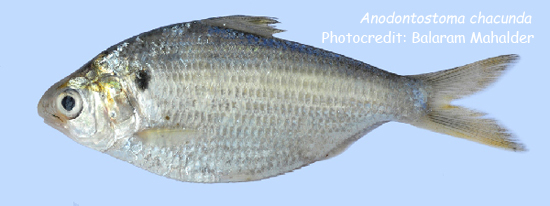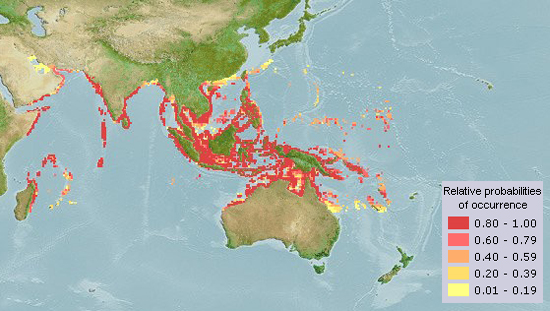
শ্রেণীতাত্ত্বিক অবস্থান (Systematic position)
পর্ব: Chordata
শ্রেণী: Actinopterygii (Ray-finned fishes)
বর্গ: Clupeiformes (Herrings)
পরিবার: Clupeidae (Herrings, shads, sardines, menhadens)
গণ: Anodontostoma
প্রজাতি: A. chacunda
নামতত্ত্ব (Etymology)
গ্রিক শব্দ ana অর্থাৎ উপরে (up), গ্রিক শব্দ odous অর্থাৎ দাঁত (teeth) ও গ্রিক শব্দ stoma অর্থাৎ মুখ (mouth) থেকে Anodontostoma শব্দটি এসেছে (fishbase 2014)।
সমনাম (Synonyms):
Clupanodon chacunda Hamilton, 1822
Chatoessus chacunda (Hamilton, 1822)
Dorosoma chacunda (Hamilton, 1822)
Anadontostoma chacunda (Hamilton, 1822)
Andontostoma chacunda (Hamilton, 1822)
Anodontasoma chacunda (Hamilton, 1822)
Anodontostoma chacundo (Hamilton, 1822)
Clupanodon chanpole Hamilton, 1822
Nematalosa chanpole (Hamilton, 1822)
Chatoessus tampo Valenciennes, 1848
Anodontostoma hasseltii Bleeker, 1849
Gonostoma javanicum Hyrtl, 1855
সাধারণ নাম (Common name)
বাংলা (বাংলাদেশ): কই পুঁটি, চাকুন্দা, চাকন্দা, চাকোনডা
বাংলা (পশ্চিমবঙ্গ, ভারত): খয়রা (Khoira)
English: Chacunda gizzard shad
উডিষ্যা (ভারত): kome, Balangi, Balango
ফিলিপাইন: Kabasi (Herre and Umali, 1948)
মায়ানমার: Bony bream (Department of Fisheries Malaysia, 2009)
ভৌগলিক বিস্তৃতি (Geographical Distribution):
আন্দামান দ্বীপপুঞ্জ ( Rajon et al, 2011); বাংলাদেশ (Rahman, 1989); পাকিস্তান, বাহরাইন (Bahrain), ইন্দোনেশিয়া, কলম্বিয়া, ইরান, ইরাক, মালয়েশিয়া (Whitehead, 1985); ভারত (Kapoor et al., 2002); মায়ানমার (Hla Win, 1987) এবং ফিলিপাইনে (Herre and Umali, 1948) এদের বিস্তৃতি রয়েছে। উষ্ণজলের এই মাছের ভৌগলিক বিস্তার 31°N – 23°S, 47°E – 171°E এবং গভীরতার বিস্তার ০-৫০ মিটার (fishbase 2014)

সংরক্ষণ অবস্থা (Conservation status):
IUCN (2012) অনুসারে এই প্রজাতিটির সংরক্ষণ অবস্থা (Conservation status) হচ্ছে Not evaluated অর্থাৎ এই প্রজাতিটির সংরক্ষণ অবস্থা এখনও মূল্যায়ন করা হয় নি।
বাহ্যিক দৈহিক গঠন (External Morphology) :
খাট দেহ অত্যন্ত চাপা। তুণ্ড সুস্পষ্ট ও চোঙাকৃতির। মুখ তির্যক, আকৃতিতে ছোট ও নিম্নমুখী। দাঁত অনুপস্থিত। এদের চর্বিময় চোখের পাতা দেখতে পাওয়া যায় না।
প্রথম ফুলকা খিলানের (gill arch) নিম্নাংশে ৮০টি ফুলকা দণ্ড (gill raker) উপস্থিত। আদর্শ ও মোট দৈর্ঘ্য মাথার দৈর্ঘ্যের যথাক্রমে ৩.৩- ৩.৭ ও ৪.৪- ৪.৮ গুণ। আদর্শ ও মোট দৈর্ঘ্য দেহের উচ্চতার যথাক্রমে ২.১- ২.৪ ও ২.৮- ৩.২ গুণ।
পৃষ্ঠপাখনা পুচ্ছের তুলনায় তুণ্ডের নিকটবর্তী স্থানে থেকে উৎপত্তি লাভ করেছে। পৃষ্ঠপাখনার ঠিক বিপরীত অবস্থান থেকে শ্রোণীপাখনার উৎপত্তি হয়েছে। পুচ্ছ পাখনা দ্বিধাবিভক্ত।
দেহের অঙ্কীয়দেশ বরাবর শ্রোণীপাখনার সম্মুখে ও পশ্চাতে যথাক্রমে ১৬-১৭টি ও ১১-১২টি স্কিউট (scute) অবস্থিত। পার্শ্বরেখায় ৩৯- ৪০ টি আঁইশ আছে, যার মধ্যে ১২- ১৫ টি পৃষ্ঠপাখনার সম্মুখে অবস্থিত। আঁইশের একপ্রান্ত মসৃণ এবং দৃঢ় অন্যপ্রান্ত দাঁতের ন্যায় খাঁজকাটা। পাশাপাশি অবস্থিত দুটি দাঁতের মধ্যবর্তী ফাঁকের চেয়ে দাঁতগুলো আকারে সরু হয়ে থাকে।
দেহের বর্ণ রূপালী। কানকুয়ার ঠিক পেছনে তথা গ্রীবায় (shoulder) কালো বর্ণের একটি বড় দাগ উপস্থিত। জীবন্ত ও তাজা অবস্থায় এদের পাখনা রশ্মি হলদেটে তবে পাখনা দেখতে স্বচ্ছ।
সর্বোচ্চ দৈর্ঘ্য (Maximum length):
Rahman (1989) অনুসারে এরা লম্বায় ১৬.৮ সেমি এবং Talwar and Jhingran (1991) অনুসারে এরা আদর্শ দৈর্ঘ্যে ১৭ সেমি হয়ে থাকে। Randall (2005) অনুসারে এরা ২২ সে মি পর্যন্ত হয়ে থাকে।
পাখনা সূত্র (Fin formula)
- D iii-v 13-15; A ii-iv 16-18; P i 14-15; V i 7 (Talwar and Jhingran, 1991)
- D. 17-18 (3/14-15); P1. 14-16; P2. 18-20 (Rahman, 1989)
স্বভাব ও বাসস্থল (Habit and Habitat)
এরা সামুদ্রিক তবে উপকূলীয় অঞ্চলের জোয়ার-ভাটার নদীতেও এদের পাওয়া যায় (Rainboth,1996)। প্রজনন ঋতুতে স্বাদুপানিতেও এদের দেখতে পাওয়া যায়। এদের অভিপ্রয়াণের প্রকৃতি anadromous ধরণের (Riede, 2004) অর্থাৎ এরা প্রজননের উদ্দেশ্যে সমুদ্র থেকে নদীতে অভিপ্রয়াণ করে থাকে।
খাদ্য এবং খাদ্যাভ্যাস (Food and feeding habit)
ফাইটোপ্লাঙ্কটন ও জুপ্লাঙ্কটন এদের প্রধান খাবার। এছাড়াও বিভিন্ন জলজ উদ্ভিদ ও উদ্ভিদাংশ, কীট, পতঙ্গ ও অন্যান্য অমেরুদণ্ডী প্রাণী এরা খেয়ে থাকে যথা – diatoms, radiolarians, mollusks, copepods, and crustaceans ইত্যাদি।
প্রজনন (Breeding)
ভারতের গোদাবরী (Godavari) মোহনায় নভেম্বর থেকে ফেব্রুয়ারি পর্যন্ত প্রজনন করে থাকে (Talwar and Jhingran, 1991)।
মৎস্য গুরুত্ব (Fishery information)
এটি ভারতীয় উপকূলের একটি সাধারণ মাছ (Talwar and Jhingran, 1991)। বাংলাদেশের বঙ্গোপসাগর ও মোহনা অঞ্চলেও প্রায়ই পাওয়া যায়। একক প্রজাতি হিসেবে এর উৎপাদন তথ্য পাওয়া যায় না। তাজা, হিমায়িত ও শুটকি অবস্থায় বাজারজাত করা হয়ে থাকে।
তথ্য সূত্র (References):
- Aquamap (2014) Computer Generated Native Distribution Map for Anodontostoma chacunda (Chacunda gizzard shad) (modelled future range map based on IPCC A2 emissions scenario). www.aquamaps.org, version of Aug. 2013. Web. Accessed 4 Nov. 2014.
- Department of Fisheries Malaysia (2009) Valid local name of Malaysian marine fishes. Department of Fisheries Malaysia. Ministry of Agriculture and Agro-based Industry. 180 p.
- Fishbase (2014) Species summary: Anodontostoma chacunda (Hamilton, 1822), Chacunda gizzard shad. Retrieve on 4 Novmber 2014 and from http://www.fishbase.org/summary/Anodontostoma-chacunda.html
- Herre AWCT and Umali AF (1948) English and local common names of Philippine fishes. U. S. Dept. of Interior and Fish and Wildl. Serv. Circular No. 14, U. S. Gov’t Printing Office, Washington. 128 p.
- Hla Win U (1987) Checklist of fishes of Burma. Ministry of Livestock Breeding and Fisheries, Department of Fisheries, Burma.
- IUCN (2012) IUCN Red List of Threatened Species. Version 2012.1 IUCN 2012. IUCN Red List of Threatened Species. Downloaded in June 2012.
- Kapoor D, Dayal R and Ponniah A.G (2002) Fish biodiversity of India. National Bureau of Fish Genetic Resources Lucknow, India.775 p.
- Rahman AKA (1989) Freshwater Fishes of Bangladesh, 1st edition, Zoological Society of Bangladesh, Department of Zoology, University of Dhaka, Dhaka-1000, pp. 257.
- Rainboth WJ (1996) Fishes of the Cambodian Mekong. FAO Species Identification Field Guide for Fishery Purposes. FAO, Rome, 265 p.
- Rajan PT, Sreeraj CR and Immanuel T (2011) Fish fauna of coral reef, mangrove, freshwater, offshore and seagrass beds of Andaman and Nicobar Islands. Zoological Survey of India, Andaman and Nicobar Regional Centre, Haddo, Port Blair.
- Randall JE (2005) Reef and shore fishes of the South Pacific. New Caledonia to Tahiti and the Pitcairn Islands. University of Hawaii Press, Honolulu, Hawaii. 720 p.
- Riede K (2004) Global register of migratory species – from global to regional scales. Final Report of the R&D-Projekt 808 05 081. Federal Agency for Nature Conservation, Bonn, Germany. 329 p.
- Talwar PK and Jhingran AG (1991) Inland Fishes of India and Adjacent Countries,Vol. I, Oxford & IBH Publishing Co. Pvt. Ltd. New Delhi-Calcutta, pp. 105.
- Whitehead PJP (1985) FAO Species Catalogue. Vol. 7. Clupeoid fishes of the world (suborder Clupeioidei). An annotated and illustrated catalogue of the herrings, sardines, pilchards, sprats, shads, anchovies and wolf-herrings. FAO Fish. Synop. 125(7/1):1-303. Rome: FAO.
Acknowledgement:
Special thanks go to Mr. Balaram Mahalder, the owner of the photograph of Anodontostoma chacunda used in the feature. Copyright: CC-BY. Retrieve on 4 November 2014 and from http://www.fishbase.org/photos/thumbnailssummary.php?Genus=Anodontostoma&Species=chacunda#
English Feature:
Visited 1,514 times, 2 visits today | Have any fisheries relevant question?
